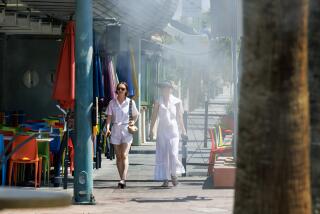Heat Melts Records a Third Straight Day
- Share via
Beaches were crowded, power usage was near capacity and stalled vehicles decorated the shoulders of freeways Tuesday as Southern California temperatures rose to record levels for the third straight day.
In Los Angeles, a hot day followed a hot night.
The Mercury reached 102 at the Civic Center shortly after 2 p.m., equaling the old record for the day, set in 1907, while the overnight low temperature of 77 was eight degrees above the record minimum for July 2, which had stood for 54 years.
The day was a few degrees cooler in San Diego, but it was still hot enough to make the record books: A 3 p.m. reading of 94 at Lindbergh Field demolished the old high temperature mark for the day--83 in 1957--while the low of 73 was just a bit hotter than the former overnight minimum record of 70, set last year.
Thermometers in Santa Barbara reached an all-time record for that city of 109 during the late afternoon, wiping out a former mark of 105, set Aug. 22, 1972.
But these were by no means the hottest readings of the day. That dubious distinction was shared by Gila Bend, Ariz., Palm Springs, and Thermal, where the temperature hit 119. Death Valley and Blythe were right behind with 118, and Needles shared its 115 top with Phoenix.
Records for the day were also set in Tucson, where a high of 109 erased the former mark of 108, set in 1953, and in Oakland, where Tuesday’s 90 degrees topped the former record of 85, set July 2, 1984.
Translated to non-statistical terms, the continuing heat wave meant a lot of extra work for lifeguards, who estimated that more than a million people abandoned homes and offices to spend a part of their day at beaches from Zuma to Newport.
And some of the beachgoers had problems.
“The waves were good--3 to 5 feet and well shaped, great for surfing,” said Los Angeles County lifeguard Dave Storer. “They were coming from a tropical storm down south. But there were plenty of riptides, plenty of once-a-summer surfers and never-been-in-the-ocean swimmers. They kept us busy. . . .”
By late afternoon, lifeguards at all beaches had reported more than 1,000 rescues--an unusually high number for a weekday, and paramedics had been called to handle more than 100 cases of heat exhaustion, sunburn--and sandburn.
“That’s right, we did have one case where someone actually had blistered the bottoms of her feet by walking on the hot sand,” said Santa Monica lifeguard David Estey. “And we had some heatstrokes, too.
“The trouble is, people who don’t come to the beach too often sometimes forget that there is little if any shade, unless they bring their own umbrellas; that it’s a long way to the refreshment stand if they don’t bring their own beverages; and that the sand soaks up heat at almost the same rate it does water.”
The California Highway Patrol had heat problems of its own: Six vehicles caught fire as the result of extreme overheating in traffic jams during the day, and a spokesman said at least 200 others stalled when cooling and air-conditioning systems were overtaxed.
No major injuries were reported in any of the incidents, but CHP officials warned motorists that any cooling system not operating at full capacity could cause a vehicle to overheat and possibly stall if confined in slow traffic during hot weather.
Power Demand
Electric utilities, which had been expecting near-capacity demands during the day, found their peak generating requirements just short of record levels--but high enough to bring all available equipment on line.
Southern California Edison spokesman Russ Hawkes said Tuesday’s peak demand of 14,331 megawatts was still well below the all-time record of 15,189 set last Sept. 5, while Department of Water and Power spokesman Steve Hinderer said the afternoon peak of 4,735 megawatts set a record for the year but still didn’t quite measure up to the all-time record of 4,882 megawatts, also set last Sept. 5.
A scattering of blackouts dotted the map--mostly resulting from transformers that failed because of the heat--but no major power outages occurred, according to the two utility spokesmen.
School Out Early
Summer school students were on minimum class schedules because of the heat, and Los Angeles Unified School District spokesman Bill Bolton said this reduced schedule will continue until the temperatures decline.
Los Angeles County extended evening pool hours for the second day in a row. The pools, which usually close at 5 p.m., remained open until 7 p.m.
First-stage smog alerts were called Tuesday in the East San Gabriel Valley, the Pomona-Walnut Valley, Riverside, Corona-Norco, the Central San Bernardino Mountains and in the east, central and southwest San Bernardino Valley.
The South Coast Air Quality Management District predicted first stage alerts today in the coastal area, metropolitan Los Angeles and the San Gabriel-Pomona Valley area.
The National Weather Service said Southern California’s heat is generated by a large upper-atmosphere high-pressure area centered over the eastern Mojave Desert. This is causing dry, hot air to move westward and is preventing an effective onshore flow of cooler marine air. Stronger sea breezes may be expected, the meteorologists said, when a low-pressure area now forming inland begins to encourage the onshore flow. But they said no real relief can be expected before the end of the week.
The search for the hottest man in Los Angeles County ended on a Pasadena rooftop. Part II, Page 1.
More to Read
Sign up for Essential California
The most important California stories and recommendations in your inbox every morning.
You may occasionally receive promotional content from the Los Angeles Times.










